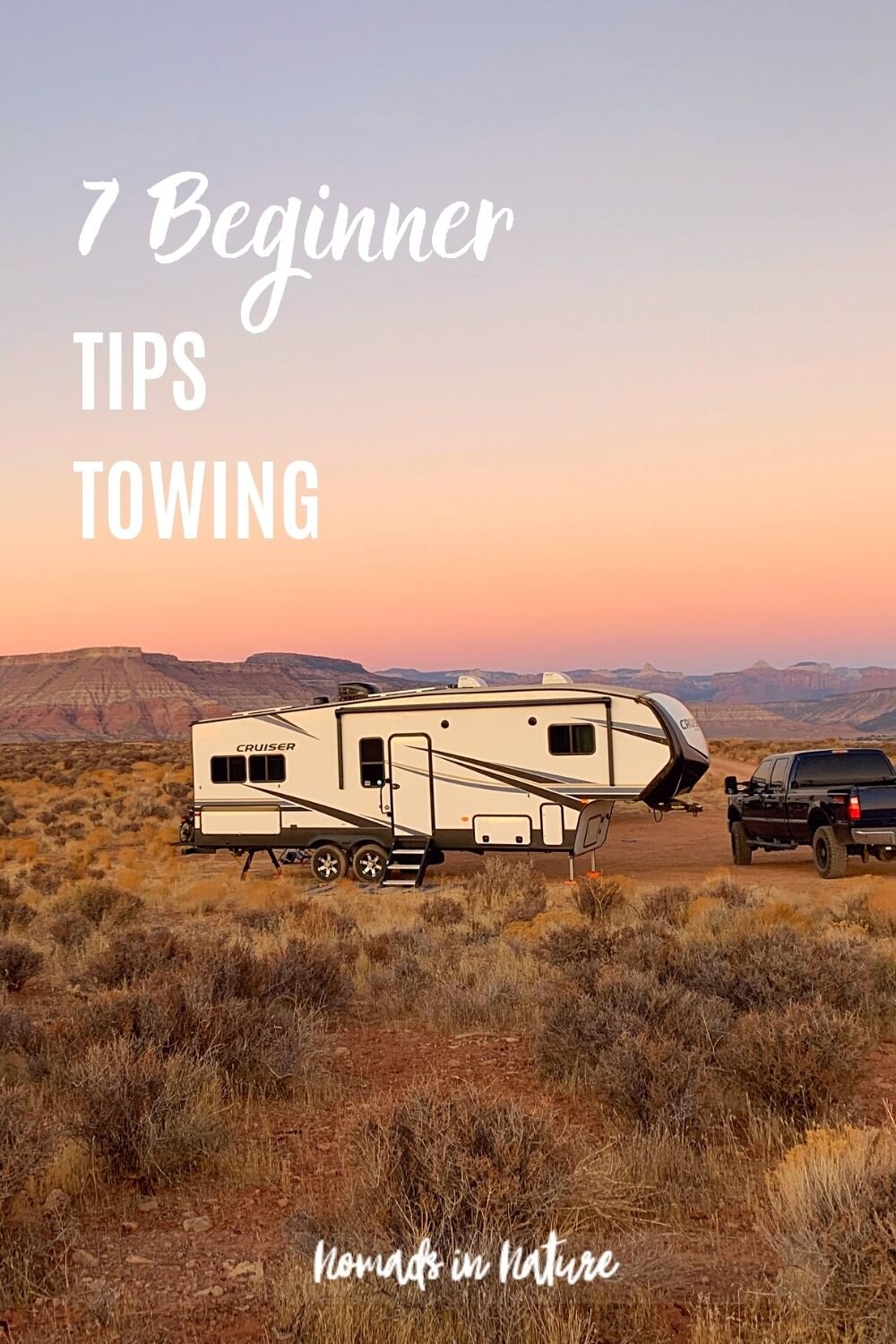7 Beginner Tips for Towing Your Fifth Wheel
When we bought our 5th wheel trailer, I had very limited towing experience. I towed a landscaping trailer one summer in college (10+ years ago), but that was it.
I had never even owned a truck before we bought ours to tow our fifth wheel. To say I was nervous about towing our home thousands of miles around the country is a huge understatement. I was terrified.
RV dealerships just give you the keys and you are on your way. No training, no certifications, nothing.
Fortunately, I learned quickly that towing a 5th wheel is much easier than I anticipated. Once I got over the initial fear, towing became second nature.
Towing our fifth wheel to a dispersed campsite outside Zion National Park
With a little practice, you can be a pro before you know it. I am going to walk you through some 5th wheel towing tips and tricks that we have learned on our journey.
Tips for Towing a Fifth Wheel
Know your RV specs
Before towing your 5th wheel, it is very important that you know the specific size and weight measurements for your truck and your RV.
Many of the new 5th wheel trailers are advertised as “half ton towable”, but this does not mean that a stock half ton truck will work.
Always make sure you confirm that your truck is rated to tow the weight of the fully loaded RV. Your truck might be able to tow more than the official rating, but insurance won’t cover you if anything goes wrong.Fifth Wheel Magazine has a great calculator that you can use to make sure your truck is rated to tow your fifth wheel. It is also very important for you to know the height, length, and width of your full rig (truck + RV).
Some roads, tunnels, and bridges have size restrictions. Getting stuck, or even losing your A/C unit could ruin your travel day.Start in an empty parking lot
You are going to need a lot of space to learn how to back up. Find the biggest parking lot near you (school, church, outlet mall, etc.) and go when no one is there.
Bring cones or other markers, and set up targets for you to back into. Start with the cones about 25 feet apart, and slowly decrease the spot width as you get more comfortable.
Most parks will have parking pads that are 12 to 18 feet wide. Shift the angle of your practice spot as each park will have a slightly different angle for you to back into.
The best advice that I can give for backing up a fifth wheel is to pull up farther than you think you need to.
Fifth wheels aren’t as responsive to turns as normal trailers, so it is important to pull up and give your rig time to start turning into the spot.Give it some juice
Most 5th wheel trailers are pretty heavy, and your truck will need some extra power to accelerate. Driving with the extra weight behind you feels weird at first, but you will get used to it.
Don’t worry too much about gas mileage when you are driving in the mountains (it won’t be pretty), and make sure you are giving your truck enough juice to get up the hills.Give yourself some room
Be cautious when you are pulling out into traffic or getting on the freeway. You won’t accelerate nearly as fast as you are used to, even if you floor it. Other drivers will get out of the way most of the time, but some people will put you in tight situations. The more room you have to get up to speed, the better off you will be.
I try to wait until I can’t see anyone on the horizon before I merge onto a fast moving road. This extra time allows me to get the rig up to speed gradually to avoid overworking the truck.Stay wide when turning
5th wheel trailers track inside of your truck. That means that the trailer tires might hit the curb on a right hand turn even if your truck tires are clear. The sharper the turn, the more the trailer will pull towards the curb.
Whenever I see a sharp turn coming up, I try to “overshoot” the turn. To overshoot your turn, drive past where you normally would turn and then cut the turn hard back.
Overshooting may result in taking up multiple lanes for a few seconds, so be cautious and make sure to look out for other drivers in nearby lanes.Communication is Key
Towing a 5th wheel trailer will test your marriage or relationship with the people you are traveling with. I suggest that you work out a communication system in advance, and use technology whenever it can help you.
The most important time for good communication is when you are navigating into your spot.Our strategy is for Taylor to get out of the truck and call me. The truck is loud, and the phone call guarantees that we can hear each other loud and clear. We have a few simple hand signals that we use for hitching the trailer and backing into a spot.
Work out a system for how you will navigate into spots, and it will save you a lot of stress.If you are frequenting areas without cells signal, you may want to invest in a pair of walkie talkies as well.
Get out and look
No matter how good your communication is, there is nothing like seeing it for yourself.
You should make sure the spot is as perfect as possible before unhitching. This includes being level, having room for the slide(s) and stairs, being close enough to hook-ups, having enough sun/shade on the RV, and setting up a great view.You won’t want to move spots once you unhitch the RV, so make sure the spot is what you want before you start unhitching.
We rushed our spot choice a few times early in our trip and moving the rig the next day was never fun. Now, we take our time and make sure everything is good before we start unhitching.
I hope that they help you get over the hump and get on the road safely. Also remember that with anything, practice is essential for comfort. You got this!



